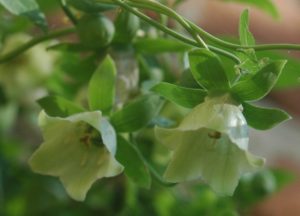Codonopsis pilosula, also known as dang shen or poor man’s ginseng, is a perennial species of flowering plant in the bellflower family. It is native to Asia, where it grows in forests, meadows, and scrub.
Uses
-
The roots of C. pilosula are used in traditional Chinese medicine. They are carrot-shaped or cylindrical, sometimes branched, and up to 30 centimeters long by 3 wide.They are a constituent of Radix Codonopsis, an herbal mix used to improve appetite and energy
Benefits
- Codonopsis is used to treat HIV infection and to protect cancer patients against side effects of radiation treatment. It is also to boost the immune system; and to treat weakness, loss of appetite (anorexia), chronic diarrhea, shortness of breath, noticeable heartbeat (palpitations), asthma, cough, thirst, and diabetes.
- Although codonopsis is sometimes used as a substitute for ginseng in general tonic formulas, none of the chemicals called saponins that are responsible for some of the effects of ginseng have been found in codonopsis.
Cautions
- Codonopsis is POSSIBLY SAFE for most people when taken by mouth in appropriate amounts.
- Special Precautions & Warnings:
- Pregnancy and breast-feeding: There is not enough reliable information about the safety of taking codonopsis if you are pregnant or breast-feeding. Stay on the safe side and avoid use.
- Bleeding disorders: Codonopsis might slow blood clotting and increase bleeding. In theory, taking codonopsis might make bleeding disorders worse.
- Surgery: Codonopsis might slow blood clotting. In theory, taking codonopsis might increase the risk for bleeding during and after surgical procedures. Stop using codonopsis at least two weeks before a scheduled surgery.
Interactions
Unknown, please consult with your doctor.
Other names
Bastard Ginseng, Bellflower, Bonnet Bellflower, Campanule à Bonnet, Chuan Dang, Codonopsis Modestae, Codonopsis pilosula, Codonopsis Pilosula Modesta, Codonopsis tangshen, Codonopsis tubulosa, Dangshen, Dong Seng, Ginseng Bâtard, Ginseng du Pauvre, Racine de Campanule à Bonnet, Radix Codonopsis, Radix Codonopsis Pilosulae
References
Source: Wikipedia, https://en.wikipedia.org/wiki/Codonopsis_pilosula
Image Source: By I, Doronenko, CC BY 2.5, https://commons.wikimedia.org/w/index.php?curid=2434723

